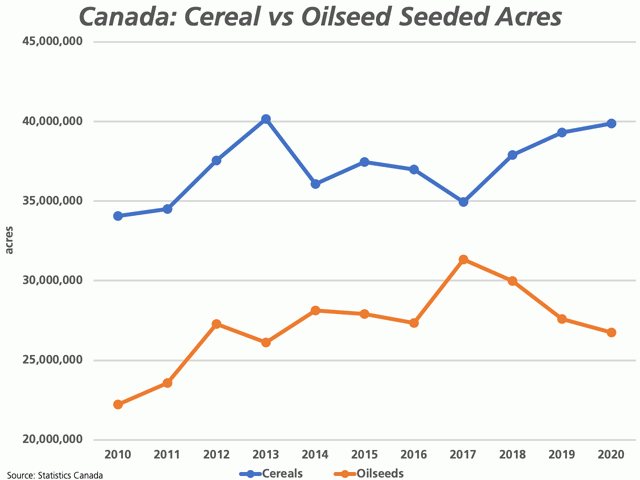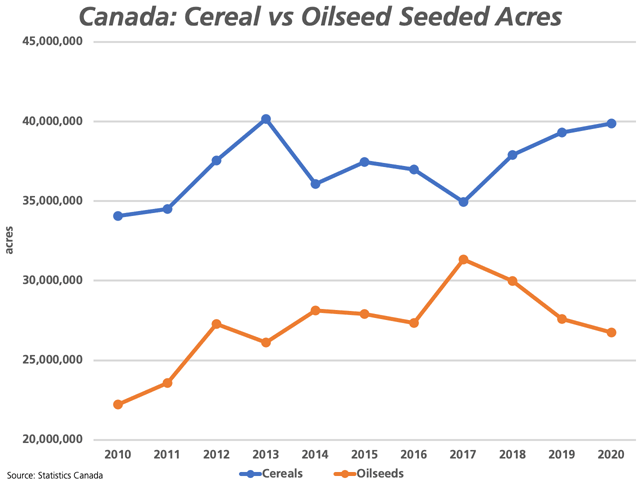Canada Markets
A Look at Statistics Canada's June Acreage Estimates
The most recent acreage estimates were welcome following the March estimates, which saw telephone surveys with producers ending abruptly in the middle of the survey period due to the COVID-19 outbreak. As a result, the first release of estimates was accompanied by warnings that the date should not be relied on heavily due to possible swings in the May/June estimates.
Monday's release is summarized by Statistics Canada as containing a "notable" increase in the area seeded to lentils, barley and durum, while the area seeded to canola and soybeans remains in decline.
Canada's all-wheat area is estimated at 24.971 million acres, below the range of pre-report estimates released by media while 1.5% higher than estimated for 2019.
The key to the increase is a sharp 16.2% increase in durum acres. Durum acres are forecast to rise to 5.689 ma, well above the March estimate and 1% higher than the five-year average. Based on AAFC's supply and demand tables, production could reach 6.1 million metric tons based on this acreage and average yields; with supplies to exceed 7 mmt, a push in exports will be required to prevent a significant build in stocks.
Spring wheat acres were estimated 4.6% lower in 2020, at 17.926 ma. The share of this acreage estimated as hard red spring wheat has fallen to 15.283 ma, falling from 88% of all spring wheat in 2019 to 85.2% of the spring wheat acres over the past year. Despite the drop in hard red spring wheat acres, the 2020 estimate is 4.5% higher than the five-year average. The acres seeded to Canada Prairie Spring Red and Canada Prairie Spring White are forecast to grow to 1.143 ma, the largest area seeded to this class since 2004.
Canola acres are forecast to fall by 0.8% year-over-year to 20.778 ma, at the higher-end of the range of pre-report estimates. There was a great deal of talk that we could see a downward revision from the 20.6 ma estimated in May. This acreage is down 4% from the five-year average, while a continued push by both exporters and crushers should result in stocks tightening in the crop year ahead.
P[L1] D[0x0] M[300x250] OOP[F] ADUNIT[] T[]
Due to the late spring season in the wetter areas of the Prairies, it was expected that barley acres and oat acres could be pushed higher. Barley acres were revised higher to 7.503 ma, up 1.4% from 2019 -- the highest seeded acres seen since 2009. Oat acres were revised slightly higher from the March estimates, while at 3.839 ma, would be the highest oat area seeded in 12 years and 18% higher than the five-year average. The barley estimate came in at the higher-end of the range of pre-report estimates, while the oat estimate fell within the range of pre-report estimates.
Dry pea acres were revised slightly lower from the March estimates, while at 4.255 ma, is down a modest 1.8% from the 2019-20 crop year and is 6% higher than the five-year average.
As expected, the forecast for lentil acres was hiked higher although at 4.233 ma, is up 12% from 2019 but still fell below the range of trade estimates reported by the media and is 1.8% below the five-year average. This number should be watched for chances of further revisions.
Statistics Canada estimated Canada's corn acres at 3.559 ma, down 3.7% from 2019 and within the range of pre-report estimates. This is the lowest area seeded in five years. All major growing provinces are forecast to reduce their seeded area, including Quebec, Ontario and Manitoba. The largest acreage drop was in Quebec with area reduced by 136,000 acres, while the largest percentage drop was in Manitoba with a 19% drop.
Canada's soybean acres is forecast to fall for a third year to 5.070 ma, the lowest volume seeded in seven years, down 11.3% from 2019 and 16.8% below the five-year average. This estimate was slightly below the range of pre-report estimates. While all major growing areas of Canada are poised to see a reduction in acres, the largest drop was seen in Ontario, where an estimated 264,300 mt or 41% of the total reduction was estimated.
As seen on the attached chart, the trend in area seeded to cereal grains remains up for a third year and to the highest area planted in seven years (wheat, durum, corn, barley, oats), while the area planted to oilseeds (canola, soybeans and flax) have fallen to the lowest seen in seven years. Both lines have diverged since 2017.
Improved trade prospects in the oilseeds could help slow the trend in lower oilseed planting. The Canadian Grain Commission's Exports of Canadian Grain and Wheat Flour report for the month of May shows exports to China in the first 10 months of the crop year at 1.5384 mmt, down from 3.0734 mmt in the same period of 2018-19. As well, no exports of soybeans are noted to China this crop year, comparted to 3.0558 mmt in the same period last crop year.
**
DTN 360 Poll
The latest poll asks readers if they think the United States-China trade deal is important to Canadian producers. You can weigh in with your thoughts on this week's poll, on the lower-right side of your DTN Home Page.
Cliff Jamieson can be reached at cliff.jamieson@dtn.com
Follow him on Twitter @Cliff Jamieson
© (c) Copyright 2020 DTN, LLC. All rights reserved.






Comments
To comment, please Log In or Join our Community .